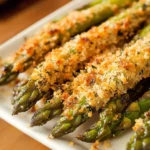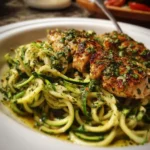Parmesan Crusted Asparagus has become a staple in our household, and for good reason! Initially, getting my family, especially the kids, to eat their greens was always a bit of a battle. Steamed asparagus? Met with sighs and pushing plates away. Boiled asparagus? Even less enthusiasm. But then, I stumbled upon this recipe for Parmesan Crusted Asparagus, and everything changed. The crispy, cheesy coating transforms the humble asparagus spear into something truly irresistible. Now, it’s not just tolerated, it’s requested! Weeknight dinners have become so much easier knowing I have a vegetable side dish that everyone genuinely enjoys. The best part? It’s incredibly simple to throw together, making it perfect for busy evenings or even a quick, elegant side for a weekend brunch. Honestly, if you’re looking for a way to make asparagus exciting and delicious, look no further. This Parmesan Crusted Asparagus is a game-changer!
Ingredients
- Fresh Asparagus: 1 pound, choose firm, bright green spears, about the thickness of a pencil for even cooking and tender texture.
- Olive Oil: 2 tablespoons, extra virgin preferred, adds flavor and helps the parmesan crust to crisp up beautifully.
- Grated Parmesan Cheese: 1/2 cup, finely grated is best for even coating and maximum cheesy flavor. Use good quality Parmesan for the best taste.
- Breadcrumbs: 1/4 cup, panko breadcrumbs recommended for extra crispiness, but regular breadcrumbs work too. They add texture and crunch to the crust.
- Garlic Powder: 1 teaspoon, adds a subtle savory garlic flavor that complements the parmesan and asparagus.
- Dried Italian Herbs: 1 teaspoon, a blend of oregano, basil, rosemary, and thyme enhances the overall flavor profile with aromatic notes.
- Salt: 1/2 teaspoon, or to taste, essential for seasoning and bringing out the flavors of all the ingredients.
- Black Pepper: 1/4 teaspoon, freshly ground preferred, adds a touch of spice and enhances the overall taste.
Instructions
- Preheat Your Oven and Prepare a Baking Sheet: Begin by preheating your oven to 400°F (200°C). This high temperature is crucial for achieving that perfect crispy parmesan crust without overcooking the asparagus. While the oven is preheating, line a baking sheet with parchment paper or aluminum foil. Parchment paper is ideal as it prevents sticking and makes cleanup a breeze. If using aluminum foil, lightly grease it with cooking spray to prevent sticking. This step ensures your asparagus doesn’t stick to the pan and cooks evenly.
- Prepare the Asparagus: Wash the asparagus thoroughly under cold running water to remove any dirt or grit. Pat the asparagus spears dry with paper towels or a clean kitchen towel. This is important because excess moisture can prevent the parmesan crust from adhering properly and becoming crispy. Next, snap off the tough, woody ends of the asparagus. To do this, hold an asparagus spear near the base and bend it gently. It will naturally snap at the point where the tender part begins. Discard the tough ends. Alternatively, you can trim the bottom inch or two of the asparagus spears with a knife. Ensuring you remove the tough ends will guarantee tender and enjoyable asparagus.
- Toss Asparagus with Olive Oil: In a medium-sized bowl, place the prepared asparagus spears. Drizzle 2 tablespoons of olive oil over the asparagus. Using your hands or tongs, toss the asparagus thoroughly to ensure each spear is evenly coated with olive oil. Olive oil not only adds flavor but also helps the parmesan mixture adhere to the asparagus and promotes browning and crisping in the oven. Even coating is key for uniform flavor and texture.
- Combine Parmesan Mixture Ingredients: In a separate small bowl, prepare the parmesan crust mixture. Combine ½ cup of grated parmesan cheese, ¼ cup of breadcrumbs (panko preferred), 1 teaspoon of garlic powder, 1 teaspoon of dried Italian herbs, ½ teaspoon of salt, and ¼ teaspoon of black pepper. Mix all these dry ingredients together thoroughly with a fork or spoon until well combined. This ensures that the flavors are evenly distributed throughout the parmesan crust mixture and that each bite of asparagus is perfectly seasoned and cheesy.
- Coat Asparagus with Parmesan Mixture: Now, it’s time to coat the asparagus with the flavorful parmesan mixture. Take the bowl of oiled asparagus and pour the parmesan mixture over the top. Using your hands or tongs, gently toss the asparagus to evenly coat each spear with the parmesan mixture. Make sure to distribute the mixture as evenly as possible so that every piece of asparagus gets a good coating of cheese and breadcrumbs. Press the parmesan mixture lightly onto the asparagus to help it adhere better.
- Arrange Asparagus on Baking Sheet: Spread the parmesan-coated asparagus in a single layer on the prepared baking sheet. Ensure that the spears are not overcrowded and have some space between them. Overcrowding can cause the asparagus to steam rather than roast, resulting in soggy asparagus instead of crispy. Arranging them in a single layer allows for proper air circulation, which is essential for achieving that desirable crispy crust and perfectly cooked asparagus.
- Bake the Asparagus: Place the baking sheet with the asparagus in the preheated oven. Bake for 10-15 minutes, or until the asparagus is tender-crisp and the parmesan crust is golden brown and crispy. The exact baking time may vary slightly depending on the thickness of your asparagus spears and your oven. Start checking for doneness around 10 minutes. The asparagus should be bright green and easily pierced with a fork, but still have a slight bite. The parmesan crust should be beautifully golden brown and crispy. Avoid overbaking, as this can result in limp and mushy asparagus.
- Serve Immediately: Once the Parmesan Crusted Asparagus is cooked to perfection, remove the baking sheet from the oven. Serve immediately while it’s hot and the parmesan crust is at its crispiest. The aroma will be incredibly tempting, and the taste even better! Parmesan Crusted Asparagus is best enjoyed fresh from the oven. Garnish with a sprinkle of extra parmesan cheese or fresh parsley, if desired, for added visual appeal and flavor.
Nutrition Facts
Servings: 4
Calories per Serving: Approximately 150
- Calories: 150 kcal
- Total Fat: 10g
(Note: Nutritional values are estimates and can vary based on specific ingredients used and portion sizes.)
Preparation Time
Prep Time: 10 minutes
Cook Time: 15 minutes
Total Time: 25 minutes
This Parmesan Crusted Asparagus is incredibly quick to prepare, making it a fantastic choice for a fast and flavorful side dish any night of the week. From washing the asparagus to serving it hot from the oven, you’ll have a delicious and healthy vegetable side on the table in under 30 minutes. The minimal prep work and short cooking time make it a go-to recipe for busy weeknights or when you need a last-minute side dish for guests.
How to Serve
Parmesan Crusted Asparagus is a versatile side dish that complements a wide variety of main courses. Its crispy texture and cheesy flavor make it a welcome addition to any meal. Here are some delicious ways to serve it:
- Alongside Grilled or Roasted Meats: Parmesan Crusted Asparagus is the perfect accompaniment to grilled chicken, steak, pork chops, or roasted lamb. The savory flavors of the asparagus and parmesan crust pair beautifully with the richness of the meats, creating a balanced and satisfying meal.
- With Fish and Seafood: The light and fresh taste of asparagus makes it an excellent partner for fish and seafood dishes. Serve it with baked salmon, pan-seared cod, grilled shrimp, or scallops. The crispy parmesan crust adds a delightful textural contrast to flaky fish.
- As a Side for Pasta Dishes: Add a serving of Parmesan Crusted Asparagus to your favorite pasta dishes for an extra boost of flavor and nutrients. It works wonderfully with creamy pasta sauces, tomato-based sauces, or pesto. Consider serving it alongside dishes like creamy Alfredo pasta, classic spaghetti marinara, or vibrant pesto pasta.
- Part of a Vegetarian or Vegan Meal: While this recipe isn’t vegan due to the parmesan, it can be adapted. For vegetarians, it’s a fantastic side to vegetarian entrees like lentil loaf, vegetable burgers, or quiche. For a vegan option, explore vegan parmesan cheese alternatives or consider a nutritional yeast and breadcrumb crust.
- As an Appetizer or Snack: Parmesan Crusted Asparagus can be enjoyed as a delicious appetizer or snack. Serve it warm with a dipping sauce like creamy aioli, ranch dressing, or a lemon-herb dip. It’s a healthy and flavorful option for parties or gatherings.
- In Salads: Cut the cooked Parmesan Crusted Asparagus into smaller pieces and add it to salads for extra flavor and texture. It’s delicious in warm salads or cold salads, adding a savory and crispy element. Try it in a salad with mixed greens, cherry tomatoes, and a light vinaigrette.
- With Eggs for Brunch: Elevate your brunch spread by adding Parmesan Crusted Asparagus. It’s a wonderful side dish for scrambled eggs, omelets, frittatas, or Eggs Benedict. The cheesy asparagus adds a touch of elegance and flavor to your brunch menu.
- As a Topping for Pizza or Flatbreads: Get creative and use Parmesan Crusted Asparagus as a topping for homemade pizza or flatbreads. It adds a unique flavor and texture dimension to your favorite pizza combinations. Consider pairing it with other vegetables, cheeses, and meats for a gourmet pizza experience.
Additional Tips for Perfect Parmesan Crusted Asparagus
To ensure your Parmesan Crusted Asparagus turns out perfectly every time, here are some helpful tips and tricks:
- Choose Asparagus Spears of Similar Thickness: When selecting asparagus, try to choose spears that are roughly the same thickness. This ensures that they cook evenly in the oven. Thicker spears will take longer to cook than thinner ones, so a uniform thickness is key for consistent results.
- Don’t Overcrowd the Baking Sheet: As mentioned earlier, avoid overcrowding the asparagus on the baking sheet. Give the spears enough space so that they roast properly and the parmesan crust gets crispy. Overcrowding can lead to steaming instead of roasting, resulting in soggy asparagus. If necessary, use two baking sheets to ensure ample space.
- Use Freshly Grated Parmesan Cheese: For the best flavor and melting quality, use freshly grated parmesan cheese rather than pre-shredded. Freshly grated parmesan has a richer, more pronounced flavor and melts more smoothly, creating a superior crust.
- Experiment with Different Breadcrumbs: While panko breadcrumbs are recommended for their extra crispiness, you can experiment with other types of breadcrumbs. Regular breadcrumbs will work well, and you can also try using Italian seasoned breadcrumbs for added flavor. For a gluten-free option, use gluten-free breadcrumbs or almond flour for a slightly different texture.
- Adjust Seasonings to Your Taste: Feel free to adjust the seasonings in the parmesan mixture to your liking. If you prefer more garlic flavor, add extra garlic powder. For a touch of heat, add a pinch of red pepper flakes. You can also experiment with other herbs like dried thyme, rosemary, or oregano to customize the flavor profile.
- Add a Squeeze of Lemon Juice After Baking: For a bright and zesty finish, squeeze a bit of fresh lemon juice over the Parmesan Crusted Asparagus just before serving. The acidity of the lemon juice complements the richness of the parmesan and brightens up the overall flavor of the dish.
- Broil for Extra Crispiness (Optional): If you want an even crispier parmesan crust, you can broil the asparagus for the last 1-2 minutes of baking. Keep a close eye on it while broiling to prevent burning. Broiling adds an extra layer of golden-brown crispiness to the top of the crust.
- Store Leftovers Properly: While Parmesan Crusted Asparagus is best served immediately, leftovers can be stored in an airtight container in the refrigerator for up to 2 days. However, keep in mind that the parmesan crust will lose some of its crispness upon refrigeration. To reheat, you can bake them in a preheated oven at 350°F (175°C) for a few minutes to warm them through and try to crisp up the crust again. Microwaving is not recommended as it will make the asparagus soggy.
FAQ Section
Q1: Can I use frozen asparagus for this recipe?
A: Fresh asparagus is highly recommended for this recipe as it provides the best texture and flavor. Frozen asparagus tends to become softer when cooked, which may result in a less crispy parmesan crust. If you must use frozen asparagus, thaw it completely and pat it very dry with paper towels before proceeding with the recipe. Be aware that the texture will be different.
Q2: What can I use if I don’t have panko breadcrumbs?
A: If you don’t have panko breadcrumbs, you can substitute them with regular breadcrumbs. Panko breadcrumbs are preferred for their extra crispiness, but regular breadcrumbs will still provide a good texture. You can also use Italian seasoned breadcrumbs for added flavor. In a pinch, crushed crackers or even finely ground almond flour can work as alternatives.
Q3: Can I make Parmesan Crusted Asparagus ahead of time?
A: Parmesan Crusted Asparagus is best served immediately after baking for optimal crispiness. While you can prepare the parmesan mixture ahead of time and store it in an airtight container, it’s recommended to assemble and bake the asparagus just before serving. If you need to prep ahead, you can wash and trim the asparagus and store it in the refrigerator until ready to use.
Q4: How do I prevent the parmesan crust from falling off the asparagus?
A: To help the parmesan crust adhere to the asparagus, make sure to toss the asparagus thoroughly with olive oil before coating it with the parmesan mixture. Press the parmesan mixture gently onto the asparagus spears to help it stick. Ensuring the asparagus is dry after washing also helps the crust adhere better.
Q5: Can I add other vegetables to this recipe?
A: While this recipe is specifically for asparagus, you can adapt the parmesan crust to other vegetables. Broccoli, green beans, and Brussels sprouts would all work well with this parmesan coating. Adjust the cooking time accordingly depending on the vegetable you choose. Root vegetables like carrots or potatoes might require parboiling before roasting with the parmesan crust.
Q6: Is this recipe gluten-free?
A: As written, this recipe is not gluten-free because it contains breadcrumbs. However, you can easily make it gluten-free by using gluten-free breadcrumbs. Alternatively, you can omit the breadcrumbs altogether or use finely ground almond flour or nutritional yeast as a substitute for a slightly different texture and flavor. Ensure all other ingredients are also certified gluten-free if needed.
Q7: Can I use a different type of cheese instead of parmesan?
A: While parmesan cheese is classic for this recipe, you can experiment with other hard, grating cheeses. Pecorino Romano, Asiago, or Grana Padano would all be delicious substitutes, offering slightly different flavor profiles. Avoid using softer cheeses as they may not crisp up as well in the oven.
Q8: How do I know when the asparagus is cooked perfectly?
A: Perfectly cooked asparagus should be tender-crisp, meaning it’s easily pierced with a fork but still has a slight bite and isn’t mushy. The color should be bright green. The parmesan crust should be golden brown and crispy. Start checking for doneness around 10 minutes of baking and adjust the time based on the thickness of your asparagus and your oven. Avoid overbaking, as it can lead to limp and overcooked asparagus.

Parmesan Crusted Asparagus
Ingredients
- Fresh Asparagus: 1 pound, choose firm, bright green spears, about the thickness of a pencil for even cooking and tender texture.
- Olive Oil: 2 tablespoons, extra virgin preferred, adds flavor and helps the parmesan crust to crisp up beautifully.
- Grated Parmesan Cheese: 1/2 cup, finely grated is best for even coating and maximum cheesy flavor. Use good quality Parmesan for the best taste.
- Breadcrumbs: 1/4 cup, panko breadcrumbs recommended for extra crispiness, but regular breadcrumbs work too. They add texture and crunch to the crust.
- Garlic Powder: 1 teaspoon, adds a subtle savory garlic flavor that complements the parmesan and asparagus.
- Dried Italian Herbs: 1 teaspoon, a blend of oregano, basil, rosemary, and thyme enhances the overall flavor profile with aromatic notes.
- Salt: 1/2 teaspoon, or to taste, essential for seasoning and bringing out the flavors of all the ingredients.
- Black Pepper: 1/4 teaspoon, freshly ground preferred, adds a touch of spice and enhances the overall taste.
Instructions
- Preheat Your Oven and Prepare a Baking Sheet: Begin by preheating your oven to 400°F (200°C). This high temperature is crucial for achieving that perfect crispy parmesan crust without overcooking the asparagus. While the oven is preheating, line a baking sheet with parchment paper or aluminum foil. Parchment paper is ideal as it prevents sticking and makes cleanup a breeze. If using aluminum foil, lightly grease it with cooking spray to prevent sticking. This step ensures your asparagus doesn’t stick to the pan and cooks evenly.
- Prepare the Asparagus: Wash the asparagus thoroughly under cold running water to remove any dirt or grit. Pat the asparagus spears dry with paper towels or a clean kitchen towel. This is important because excess moisture can prevent the parmesan crust from adhering properly and becoming crispy. Next, snap off the tough, woody ends of the asparagus. To do this, hold an asparagus spear near the base and bend it gently. It will naturally snap at the point where the tender part begins. Discard the tough ends. Alternatively, you can trim the bottom inch or two of the asparagus spears with a knife. Ensuring you remove the tough ends will guarantee tender and enjoyable asparagus.
- Toss Asparagus with Olive Oil: In a medium-sized bowl, place the prepared asparagus spears. Drizzle 2 tablespoons of olive oil over the asparagus. Using your hands or tongs, toss the asparagus thoroughly to ensure each spear is evenly coated with olive oil. Olive oil not only adds flavor but also helps the parmesan mixture adhere to the asparagus and promotes browning and crisping in the oven. Even coating is key for uniform flavor and texture.
- Combine Parmesan Mixture Ingredients: In a separate small bowl, prepare the parmesan crust mixture. Combine ½ cup of grated parmesan cheese, ¼ cup of breadcrumbs (panko preferred), 1 teaspoon of garlic powder, 1 teaspoon of dried Italian herbs, ½ teaspoon of salt, and ¼ teaspoon of black pepper. Mix all these dry ingredients together thoroughly with a fork or spoon until well combined. This ensures that the flavors are evenly distributed throughout the parmesan crust mixture and that each bite of asparagus is perfectly seasoned and cheesy.
- Coat Asparagus with Parmesan Mixture: Now, it’s time to coat the asparagus with the flavorful parmesan mixture. Take the bowl of oiled asparagus and pour the parmesan mixture over the top. Using your hands or tongs, gently toss the asparagus to evenly coat each spear with the parmesan mixture. Make sure to distribute the mixture as evenly as possible so that every piece of asparagus gets a good coating of cheese and breadcrumbs. Press the parmesan mixture lightly onto the asparagus to help it adhere better.
- Arrange Asparagus on Baking Sheet: Spread the parmesan-coated asparagus in a single layer on the prepared baking sheet. Ensure that the spears are not overcrowded and have some space between them. Overcrowding can cause the asparagus to steam rather than roast, resulting in soggy asparagus instead of crispy. Arranging them in a single layer allows for proper air circulation, which is essential for achieving that desirable crispy crust and perfectly cooked asparagus.
- Bake the Asparagus: Place the baking sheet with the asparagus in the preheated oven. Bake for 10-15 minutes, or until the asparagus is tender-crisp and the parmesan crust is golden brown and crispy. The exact baking time may vary slightly depending on the thickness of your asparagus spears and your oven. Start checking for doneness around 10 minutes. The asparagus should be bright green and easily pierced with a fork, but still have a slight bite. The parmesan crust should be beautifully golden brown and crispy. Avoid overbaking, as this can result in limp and mushy asparagus.
- Serve Immediately: Once the Parmesan Crusted Asparagus is cooked to perfection, remove the baking sheet from the oven. Serve immediately while it’s hot and the parmesan crust is at its crispiest. The aroma will be incredibly tempting, and the taste even better! Parmesan Crusted Asparagus is best enjoyed fresh from the oven. Garnish with a sprinkle of extra parmesan cheese or fresh parsley, if desired, for added visual appeal and flavor.
Nutrition
- Serving Size: one normal portion
- Calories: 150
- Fat: 10g






